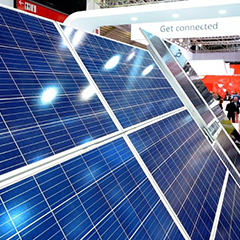Munich/Pforzheim, February 11, 2021 – Photovoltaics (PV) is booming in Europe, with around 18.7 gigawatts of new capacity installed last year. In addition to rooftop and ground-mounted solar module installations, the development of new areas of production – such as on façades, artificial bodies of water and fields – is key. Agrivoltaics involves the use of agricultural land to produce food and generate solar energy simultaneously. Conventional free-standing installations can also provide a valuable habitat for flora and fauna, which in turn promotes the acceptance of both the installations and the energy transition as a whole. Find out more about new developments and potential applications for PV at Intersolar Europe, the world’s leading exhibition for the solar industry, and the accompanying Intersolar Europe Conference. Both events will be held as part of The smarter E Europe from July 21 to 23, 2021, at Messe München.
The European PV market is experiencing dynamic growth. The industry association SolarPower Europe reports that the European Union (EU) saw an eleven percent increase in PV capacity last year, with 18.7 gigawatts (GW) of newly installed capacity. This made 2020 the industry’s second best year, topped only by 2011. The strong growth of PV is also reflected in the total amount of power generated in the EU. 2020 marked the first time that the EU generated more power from renewable sources than from fossil fuels, according to a study by Agora Energiewende and the British think tank Ember entitled The European Power Sector in 2020. Renewable energies made up 38 percent of the European energy mix in 2020, compared with fossil fuels making up only 37 percent.
In Germany – by far the EU’s largest PV market – 4.8 GW of solar capacity were added last year, and renewable energies accounted for more than 50 percent of net public electricity generation, i.e. the energy mix that actually comes out of the socket. However, market researchers warn of a potential gap in the German energy supply as early as 2023. To ensure supply security and achieve climate targets, the current rate of photovoltaic expansion must double by 2021 and triple by 2022. In the interest of promoting photovoltaic expansion and using space efficiently, solar modules are no longer limited to rooftop installations and free-standing systems. In the future, modules on façades, agrivoltaics and floating PV could open up even more production areas, making them an additional driver of photovoltaic growth.


























